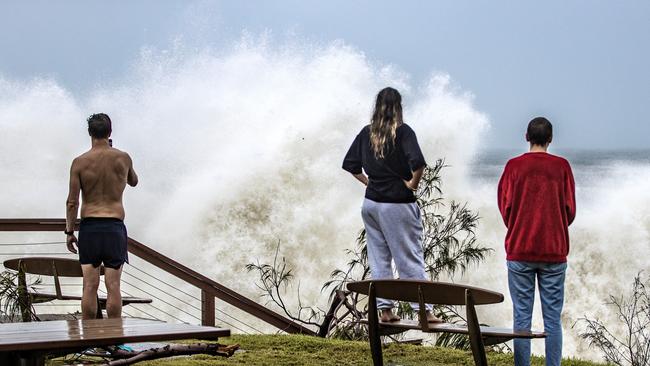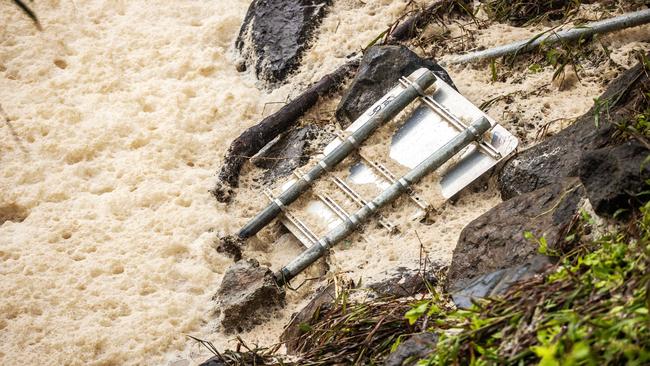Doomsayers push climate of fear as Alfred hits

With Cyclone Alfred bearing down on southern Queensland, most people’s thoughts turned to hoping the worst of it might be averted. That the storm might weaken. That by a miracle it might miss major population centres. That the loss of life, the injuries, the destruction somehow might be limited.
But the Climate Council saw a business opportunity: another chance to terrify people into believing that this cyclone was a creature of climate change.
The council issued a media “talent alert” offering a menu of experts keen to link the storm to global warming, even though the release itself noted “a warmer world means fewer but more destructive cyclones”.
That’s right, there have been fewer cyclones making landfall in Australia in recent decades, according to all the best research.
It is detailed in the UN Intergovernmental Panel on Climate Change report Climate Change 2021: The Physical Science Basis.
On page 1586 it says: “(Tropical cyclone) landfall frequency over Australia shows a decreasing trend in eastern Australia since the 1800s, as well as in other parts of Australia since 1982. A paleoclimate proxy reconstruction shows that recent levels of (tropical cyclone) interactions along parts of the Australian coastline are the lowest in the past 550-1500 years.”
Surely this bit is good news. But what of the fears of “more destructive” cyclones?
Here the Climate Council appears to be on solid ground because it quotes from the 2024 State of the Environment Report, a joint effort by the Bureau of Meteorology and the CSIRO.
“Fewer tropical cyclones, but with higher intensity on average, and greater impacts when they occur through higher rain rates and higher sea level,” the report says on page three.
But roll forward to page 13 of the same report, under the heading Tropical Cyclones, and it says: “The trend in cyclone intensity in the Australian region is harder to quantify than cyclone frequency, due to uncertainties in estimating the intensity of individual cyclones and the relatively small number of intense cyclones.”
What are we to make of a report co-authored by two of the most respected scientific bodies in Australia that is so internally inconsistent?
On March 4, the CSIRO published an article on cyclones. Here it was more precise.
“There is a projected increase in (tropical cyclone) peak intensity, on average. We also expect to see an increase in the proportion of tropical cyclones that reach the more intense categories (category 4 or 5).
“However, there is large uncertainty in these projections due to challenges associated with modelling tropical cyclone physics in coarse-resolution climate models.”

So, models project storms might become more intense but they are qualified by “large uncertainty”. What about empirical observations, which are the bedrock of the scientific method?
Returning to the IPCC report, on page 1583 it says “there is low confidence in observed long-term (40 years or more) trends in (tropical cyclone) intensity, frequency, and duration”.
Professor Roger Pielke has spent decades researching what the Americans call hurricanes. In 2024 he published an article on global tropical cyclones that drew on a data set maintained by Colorado State University. Its records date from 1980 and it uses a metric called Accumulated Cyclone Energy, which combines cyclone frequency and intensity.
Pielke notes: “Over this time period and according to these metrics, hurricanes have not become more intense.”
Cyclones making landfall as far south as Brisbane are rare but Alfred is not unique.
The Brisbane Times reviewed the history of similar events and noted: “The last tropical cyclone to cross the southeast Queensland coast was ex-Tropical Cyclone Zoe in 1974, which arrived less than two months after Cyclone Wanda caused the catastrophic 1974 Brisbane floods.
“In January 1887 gale-force winds and heavy rains inundated the southeast corner, with buildings at Sandgate washed away, and 70 people reported dead.
“Across late January and February 1893, no less than five cyclones crossed the southeast and central Queensland coasts, sparking the Great Flood of Brisbane.”
There is no evidence that Alfred was caused by climate change. There is no evidence that burning less coal, oil and gas in Australia would have averted it or made it less ferocious. But that is precisely what the Climate Council, the Greens and a cavalcade of other politicians and activists intend to suggest as the media feeds on the fear they sow.
It’s all part of a pattern of climate misinformation that washes around the globe, echoed by governments, international institutions and the media as all aim to terrify populations into accepting wrenching and expensive change.
Perhaps the worst offender is UN secretary-general Antonio Guterres and the organisation he leads. Swedish public radio recently broadcast an investigation by journalist Ola Sandstig into four oft-repeated claims about global warming: that climate change kills 1.7 million children under the age of five every year; that women and children are 14 times likelier to die in natural disasters than men; that the number of weather disasters has increased fivefold since the 1970s; and that families in Samoa are abandoning their homes and moving inland because of climate change.
All are grossly misleading. The 1.7 million claim appears on the UNICEF website. Sandstig notes this number is 40 times higher than the average total yearly deaths recorded from natural disasters across the past decade. The figure is drawn from two World Health Organisation reports and neither refers to climate change. Both focus on traditional environmental killers such as indoor and outdoor air pollution and fetid water.
Numerous UN agencies claim that women and children are 14 times likelier than men to die in natural disasters. Sandstig traced that claim to a report written 27 years ago by anthropologist Kristina Peterson, who took one piece of anecdotal evidence from one disaster and included it in a 1997 article in the journal Natural Hazards Observer. The author says it was never intended to be a metric for all disasters.
“You know what’s crazy is I’ve had people call me about it and I have said ‘No, don’t use that’,” she told Sandstig. “Would you use data on climate from 25 years ago? I thought people had more sense.”
The claim that the weather disasters have increased fivefold since the 1970s has been spread by the World Meteorological Organisation and broadcast by Guterres himself. The source of this number is the Brussels-based Emergency Events Database.
The pioneer of that database, Professor Debarati Guha-Sapir, told Sandstig the rise was primarily due to a massive increase in reports on disasters because of better communications. It would be “dangerous and misleading” to claim there was a fivefold increase in weather-related disasters in the past 50 years.
“You can actually argue that climate disasters, or natural disasters, have not actually substantially increased but the reporting has been much easier, much better, much quicker,” Guha-Sapir said.
Last year, Guterres travelled to Samoa, stood in front of an abandoned home on a beach, and recorded a message posted on X.
“Those who lived in these houses had to move their homes further inland because of sea level rise and the multiplication of storms,” Guterres said.
Sandstig interviewed a member of the family that abandoned the house in 2009. They left after the 2009 earthquake and tsunami. Neither is connected to climate change.
Here Pielke takes up the story: “Relative sea level rise has accelerated in Samoa. But that also has nothing to do with climate change but, rather, increased subsidence following the 2009 earthquake.”
“UN secretary-general Guterres’ Samoan photo op and press release can only be described as an intentional effort to mislead,” Pielke says.
The prophets of an impending climate apocalypse appear to believe that weaponising lies for a noble cause is justified. But one day the truth will out, leaving those who traded in fear with nothing but the ruins of their credibility among the ashes of their cause.




Even before the storm hit, the distortions began.